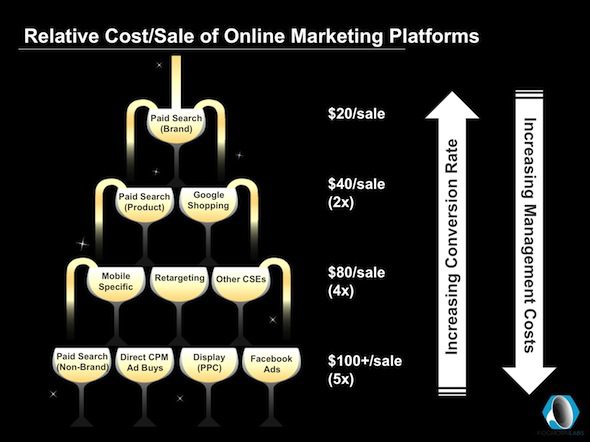One of the most common questions we get from clients is:
“if we can secure additional PPC budget, where should it be allocated?”
Pay per click (PPC) channels capable of generating a low cost per sale have limited traffic. As a result, growing businesses must look elsewhere for incremental traffic. Among keyword-based ad campaigns, branded keywords usually have the lowest cost per sale because users searching for branded terms tend to have at least one of the following qualities:
- they are brand-loyal
- they are return customers
- they heard about the brand by word-of-mouth
- they discovered the brand’s products through a product review or article
After branded terms, product searches and comparison shopping engine traffic tend to be the next best route. From there, it becomes increasingly challenging to find sources of PPC traffic that yield a positive return on ad spend (ROAS).

The cost per sale numbers referenced above are relative and reflect averages across anonymous direct-to-consumer PPC accounts we manage. Using the cost per sale of Google Ads brand terms as a base, in this case $20, you could assume:
- Cost per sale for product terms would be approximately 2x ($40)
- Cost per sale for retargeting on the Google Display Network will be 4x ($80)
- Cost per sale for non-brand search terms, display and social media ads would be 5x or more ($100+)
This is not an absolute formula as there tend to be variables at play including account structure, landing page quality and eCommerce conversion rate, but we’ve found it to be a good starting point for PPC budget allocation. It’s worth noting that compelling events like major product launches, deep discounts and seasonal events tend to lower cost per sale across the board.
Determining where to allocate incremental PPC dollars also comes up in cases where an advertiser has an “uncapped” budget, meaning that they don’t set spend limits provided that a cost per sale or ROAS goal is met. For advertisers with this strategy we design and set up campaigns for each platform that are highly likely to fall within that advertiser’s goal(s), then turn them on or off based on seasonal performance.
It’s common for PPC platforms to generate a positive ROAS during peak season (ie. holiday or back-to-school), but a negative one during other times of the year. For this reason, we rarely run all platforms simultaneously throughout the year.
A note about management costs:
Brand terms tend to be the least complex and time-intensive of any category of keywords in paid search. This is because brand terms don’t evolve at the same rate as product or general terms which constantly need to be updated based on product churn, seasonal variations and search query trends.
As we move down the pyramid toward platforms that are branding and awareness-focused, it becomes increasingly challenging and time-intensive to stay within cost per sale and ROAS goals.
For platforms like Facebook advertising and display, we set higher cost per sale goals that account for assisted conversions. Google Analytics has some insightful reports that separate first from last click attribution, giving advertisers a metric that more accurately reflects an ad platform’s true ROI.

Conversions > Multi-Channel Funnels > Assisted Conversions
